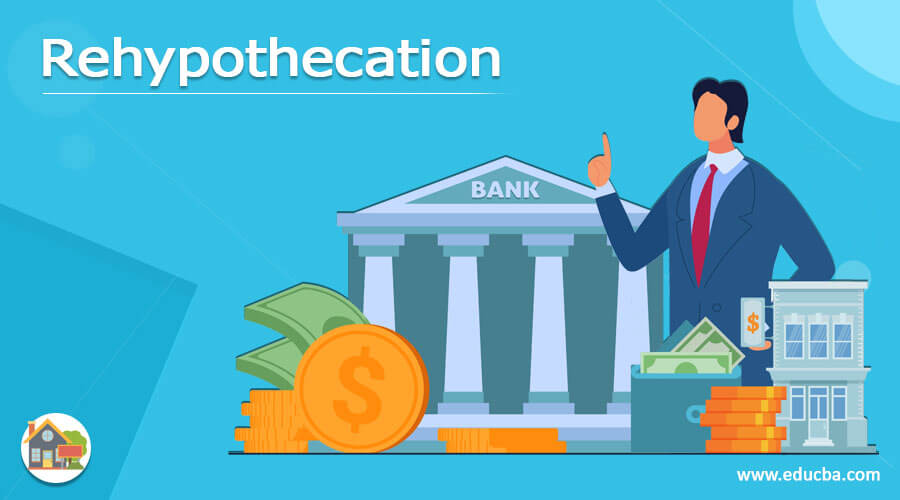Updated June 21, 2023
What is Rehypothecation?
The term “rehypothecation” refers to the practice wherein financial institutions (such as brokers and banks) reuse the assets already provided as collateral by their borrowers to secure the debt. In exchange, the financial institutions offer a rebate or cut down the cost of borrowing for the borrowers who permit the rehypothecation of their collateral. After rehypothecation, the original lender is no longer in control of the collateral provided by the borrower; instead, the lender’s lender becomes the ultimate controller of the collateral.
How does Rehypothecation Work?
When a borrower decides to provide an asset as collateral to secure a loan from a bank or other financial institution, it is known as hypothecation. Later, if the bank chooses to reuse the collateral to raise funds from another financial institution, the initial lender engages in rehypothecation. Effectively, the initial lender pledges the borrower’s collateral to raise funds, resulting in a shift of control over the collateral from the initial lender to the next. However, the original borrower is rewarded with a lower borrowing cost to facilitate the rehypothecation transaction.
Examples of Rehypothecation
Let us look at the following example to understand the concept of rehypothecation.
Suppose David required capital for his new business. He decided to mortgage his house and get the bank to sanction the amount needed for his business. Therefore, David had entered into a hypothecation agreement with Bank A.
A few months later, Bank A faced a liquidity crunch, so it decided to indulge in another financial transaction with Bank B. In this transaction, Bank A borrowed money from Bank B using the house offered by David as collateral. As a result, David received a lower cost of borrowing, which reduced his monthly payment and interest burden.
In this scenario, Bank B gained control of the house from David through intermediary Bank A, illustrating the process of rehypothecation.
Consequences of Rehypothecation
A financial institution can borrow additional funds by pledging the borrower’s collateral for the second time. So, the same collateral now stands the burden of multiple debts. The first debt refers to a loan extended by the initial lender to the original borrower. The second debt refers to borrowing by the initial lender from a third-party lender. Therefore, the collateral ultimately passes from the original borrower to the third-party lender through the initial lender.
The worst possible outcome in this cycle could be the initial lender’s default. In such a scenario, the third-party lender would seize the collateral initially belonging to the borrower. The original borrower could log into his account and discover that someone had wiped out the asset. In other words, a borrower intending to repay the loan in time could find their valuable asset gone. However, the most surprising part is that the process is very legal.
Elements of Rehypothecation
A typical rehypothecation arrangement consists of the following elements:
- An asset to be provided as collateral
- A borrower who is the original owner of the collateral
- An initial lender first extends a loan to the borrower based on the collateral
- A third-party lender who provides money to the initial lender in exchange for the collateral
Advantages of Rehypothecation
Some of the significant advantages of rehypothecation are as follows:
- Lenders reward borrowers who allow them to reuse their assets as collateral in rehypothecation arrangements by offering a certain amount of rebate or a lower cost of borrowing. This way, the borrowers can save money due to lower interest rates.
- When banks and other financial institutions are in a liquidity crunch and require capital, rehypothecation can be a plausible option for access to capital. It can emerge as the savior in such an occasion.
- Rehypothecation of securities leads to necessary trading, which helps in price discovery and increases capital markets’ efficiency.
Disadvantages of Rehypothecation
Some of the significant disadvantages of rehypothecation are as follows:
- First, there may be times when the original borrowers are kept in the complete dark and unaware that they have signed on to a rehypothecation clause, which means that lenders are free to further rehypothecate the collateral for speculative purposes.
- Given the high level of leverage due to rehypothecation, a default by the underlying entity can have a catastrophic impact on the overall financial system.
- There may be times when financial institutions may choose to misuse the underlying collateral for their benefit.
Key Takeaways
Some of the key takeaways of the article are:
- Rehypothecation refers to the practice of the reuse of an already pledged collateral as the collateral for another new loan.
- Although rehypothecation improves liquidity in the market, it significantly increases the risk of default for everyone in the chain related to the piece of collateral.
- An asset that has been rehypothecated multiple times can potentially send shockwaves through the market, wiping out the original investments of many in the market.
Conclusion
Rehypothecation is a commonly used method by banks and other financial institutions to secure further liquidity in the banking system. It allows financial institutions to access more capital by reusing the original borrowers’ collateral. However, employing the method with proper care is essential as otherwise, it can result in severe consequences damaging all involved in the value chain.
Recommended Articles
This is a guide to a Rehypothecation. Here we also discuss the definition, working, examples, consequences, elements, advantages, and disadvantages. You may also have a look at the following articles to learn more –




